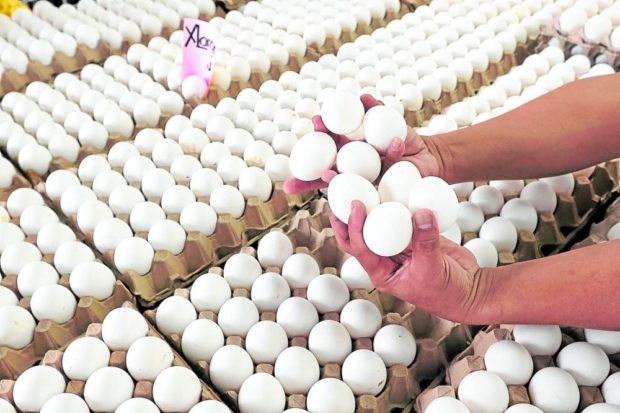
FOR CLOSE MONITORING | The Department of Agriculture is reactivating a price monitoring committee and tapping several advisory groups in the poultry sector to focus on the demand-and-supply situation in the egg industry. (Photo by GRIG C. MONTEGRANDE / Philippine Daily Inquirer)
MANILA, Philippines — Another important food commodity is adding to price woes that the Marcos administration must now grapple with: eggs, which are a key source of protein for many Filipinos.
Based on the price monitoring report of the Department of Agriculture (DA), the selling price for a single, medium-sized egg in markets in Metro Manila ranges from as low as P6.90 to as high as P8.70 as of Wednesday, higher than the price range of P5 to P6.50 apiece recorded during the same period last year.
To address the situation, the DA has reconvened the Price and Volume Watch Committee and Advisory Groups for Livestock and Poultry to closely monitor the prices of eggs across the country.
Gregorio San Diego, chair of the United Broilers Raisers Association (Ubra), said egg farmers had been grappling with high costs of production.
The cost of feed inputs alone, he said, accounts for almost P5 of each egg’s selling price.
“Although the price of eggs has increased, we’re not losing money. But we are not earning that much despite a reasonable farm-gate price,” San Diego said in a briefing.
Ubra president Elias Jose Inciong said that although they welcome the DA’s latest move to revitalize the price and volume watch, it would be helpful to get other agencies involved as well.
Inciong said tapping other government offices like the National Economic and Development Authority, Philippine Statistics Authority, Department of Finance and Bureau of Customs would make for “a complete consultative arrangement.”
Hot-button issues
The first six months of the Marcos administration have been beset with food supply concerns.
Before eggs, two other major commodities — sugar and onions — have become hot-button issues that put the president’s campaign promise of agricultural self-sufficiency to test.
Early this month, the DA authorized the importation of 21,060 metric tons (MT) of onions — 17,100 MT of red onions and 3,960 MT of yellow onions — hoping to bring down prices that have ranged from P400 to P700 per kilo.
The decision to import drew objections from some lawmakers and agribusiness groups who questioned the timing since the local onion harvest season would soon start next month. Importers were given until Jan. 27 to complete their shipments to the country.
In December last year, President Ferdinand Marcos Jr. also ordered the DA to expedite the entry of 64,050 MT of imported refined sugar via the minimum access volume (MAV) mechanism, also to arrest price surges.
Demand-supply situation
Agriculture Assistant Secretary Kristine Evangelista said Inciong’s proposal was a “welcome suggestion” that would help the government in finding ways to manage the supply and demand of food products.
“I think it would be helpful so we can see all sides, different perspectives, and come up with a solution because every now and then, they are also part of the group that has to find ways to correct inflation. Having other agencies involved will probably be beneficial,” she told reporters in an interview.
“That is something that will be helpful so that we can assess the sufficiency of any commodity, but particularly of livestock,” she added.
Among others, the technical committee of the Price and Volume Watch Committee for Livestock and Poultry shall serve as the technical advisory body of the agriculture secretary — a post currently held by Marcos — in terms of the demand-and-supply situation of livestock commodities, meat and meat products prices, both local and international, and volume gaps.
Advisory groups
It shall also call for regular and emergency meetings with the advisory groups “to discuss issues or concerns affecting the livestock and poultry industry, prices, importation, animal disease situations, minimum access volume levels, importation, cold storage inventories and [market] outlook.”
In an order dated Jan. 10, the DA revived advisory groups for livestock and poultry, comprised of the following: Swine Advisory Group, Broiler and Layer Advisory Group, Meat Importers and Processors Advisory Group, Ruminant Advisory Group, and Vendors Advisory Group.
These groups are called upon to assist in the monitoring of livestock, poultry, eggs, meat and meat product prices, and other allied industries such as feeds, including demand and supply trends.
They are expected to provide reliable industry information regarding price movements and help implement programs to arrive at more predictable production and consumption patterns.
The order also called for the setup of price and volume watch committees and advisory groups in the Ilocos Region, Central Luzon, Calabarzon (Cavite, Laguna, Batangas, Rizal, and Quezon), Northern Mindanao, and Soccsksargen.